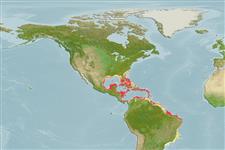>
Eupercaria/misc (Various families in series Eupercaria) >
Haemulidae (Grunts) > Haemulinae
Etymology: Haemulon: Greek, haimaleos = bloody (Ref. 45335).
Environment: milieu / climate zone / distribuzione batimetrica / distribution range
Ecologia
marino associati a barriera corallina; distribuzione batimetrica 0 - 60 m (Ref. 36484). Subtropical; 34°N - 34°S, 98°W - 34°W
Western Atlantic: Bermuda, South Carolina (USA), and northern Gulf of Mexico to Brazil; throughout the West Indies and the coasts of Central America (Ref. 3798).
Length at first maturity / Size / Peso / Age
Maturità: Lm 16.0 range ? - ? cm
Max length : 30.0 cm TL maschio/sesso non determinato; (Ref. 7251); common length : 17.0 cm TL maschio/sesso non determinato; (Ref. 3798)
Spine dorsali (totale) : 12; Raggi dorsali molli (totale) : 14 - 15; Spine anali: 3; Raggi anali molli: 8. Mostly yellow, paler below. Scales below lateral line in oblique rows and much larger than those above lateral line. No other grunt has enlarged scales below the lateral line (Ref. 26938).
Body shape (shape guide): short and / or deep.
Occurs in large schools on rocky and coral reefs, often under ledges or close to elkhorn coral (Ref. 9710). Juveniles abundant in near-shore seagrass beds (Ref. 9710). Feeds mainly on small crustaceans (Ref. 3798). Marketed fresh (Ref. 3798).
Life cycle and mating behavior
Maturità | Riproduzione | Deposizione | Uova | Fecundity | Larve
Oviparous, distinct pairing during breeding (Ref. 205).
Robins, C.R. and G.C. Ray, 1986. A field guide to Atlantic coast fishes of North America. Houghton Mifflin Company, Boston, U.S.A. 354 p. (Ref. 7251)
IUCN Red List Status (Ref. 130435: Version 2025-1)
Threat to humans
Reports of ciguatera poisoning (Ref. 30303)
Human uses
Pesca: commerciale; Acquario: Acquari pubblici; esca: usually
Strumenti
Special reports
Download XML
Fonti Internet
Estimates based on models
Preferred temperature (Fonte Biblio.
123201): 25.4 - 28, mean 27.2 °C (based on 240 cells).
Phylogenetic diversity index (Fonte Biblio.
82804): PD
50 = 0.5000 [Uniqueness, from 0.5 = low to 2.0 = high].
Bayesian length-weight: a=0.01349 (0.00859 - 0.02117), b=3.00 (2.87 - 3.13), in cm total length, based on LWR estimates for this species & Genus-body shape (Ref.
93245).
Trophic level (Fonte Biblio.
69278): 3.5 ±0.1 se; based on diet studies.
Resilienza (Fonte Biblio.
120179): Medio, tempo minimo di raddoppiamento della popolazione 1.4 - 4.4 anni (K=0.24).
Fishing Vulnerability (Ref.
59153): Low to moderate vulnerability (32 of 100).
🛈
Nutrients (Ref.
124155): Calcium = 26.7 [11.5, 74.1] mg/100g; Iron = 0.579 [0.281, 1.123] mg/100g; Protein = 19.5 [17.5, 21.5] %; Omega3 = 0.169 [0.076, 0.330] g/100g; Selenium = 15.4 [7.0, 31.3] μg/100g; VitaminA = 38 [10, 140] μg/100g; Zinc = 0.714 [0.431, 1.162] mg/100g (wet weight);
